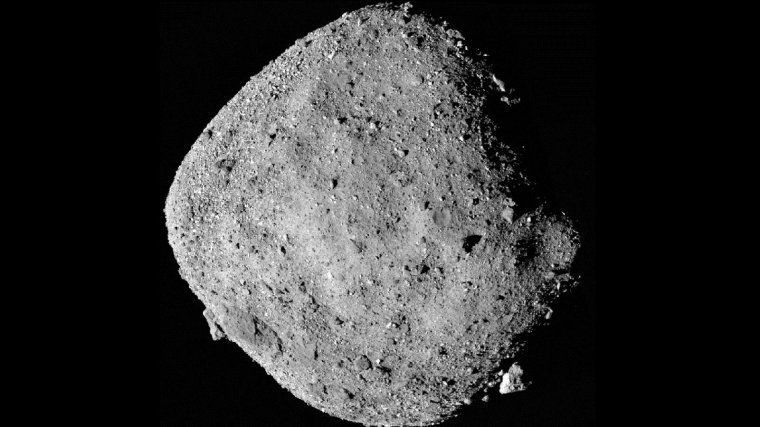| News / Science News |
Why Is Asteroid Bennu Ejecting Particles Into Space?
When NASA's OSIRIS-REx spacecraft arrived at asteroid (101955) Bennu, mission scientists knew that their spacecraft was orbiting something special. Not only was the boulder-strewn asteroid shaped like a rough diamond, its surface was crackling with activity, shedding small pieces of rock into space.

This mosaic image of asteroid Bennu is composed of 12 images collected on Dec. 2, 2018, by the OSIRIS-REx spacecraft's PolyCam instrument from a range of 15 miles (24 kilometers). Credit: NASA/Goddard/University of Arizona
Typically, we consider comets, not asteroids, to be the active ones. Comets are composed of ice, rock, and dust. As those ices are heated by the Sun, the vapor fizzes from the surface, dust and chunks of the comet nucleus are lost to space, and a long dusty tail forms.
Asteroids, on the other hand, are composed mainly of rock and dust (and perhaps a smaller quantity of ice), but it turns out some of these space rocks can be surprisingly lively, too.
Cameras on OSIRIS-REx (short for Origins, Spectral Interpretation, Resource Identification, and Security-Regolith Explorer) spotted rock particles being repeatedly launched into space during a January 2019 survey of the asteroid, which is about a third of a mile (565 meters) wide at its equator.
One of the studies, led by senior research scientist Steve Chesley at NASA's Jet Propulsion Laboratory in Southern California, found that most of these pebble-size pieces of rock, typically measuring around a quarter-inch (7 millimeters), were pulled back to Bennu under the asteroid's weak gravity after a short hop, sometimes even ricocheting back into space after colliding with the surface.
Others took longer to return to the surface, remaining in orbit for a few days and up to 16 revolutions. And some were ejected with enough oomph to completely escape from the Bennu environs.
By tracking the journeys of hundreds of ejected particles, Chesley and his collaborators were also able to better understand what might be causing the particles to launch from the surface of Bennu.
The particle sizes match what is expected for thermal fracturing (as the asteroid's surface is repeatedly heated and cooled while it rotates), but the locations of the ejection events also match the modeled impact locations of meteoroids (small rocks hitting the surface of Bennu as it orbits the Sun).
It may even be a combination of these phenomena, added Chesley. But to come to a definitive answer, more observations are needed.
While their very existence poses numerous scientific questions, the particles also served as high-fidelity probes of Bennu's gravity field. Many particles were orbiting Bennu far closer than would be safe for the OSIRIS-REx spacecraft, and so their trajectories were highly sensitive to the irregular gravity of Bennu.
This allowed researchers to estimate the Bennu's gravity even more precisely than was possible with OSIRIS-REx's instruments.
On average, only one or two particles are ejected per day, and because they are in a very low-gravity environment, most are moving slowly. As such, they pose little threat to OSIRIS-REx, which will attempt to briefly touch down on the asteroid on Oct. 20 to scoop up surface material, which may even include particles that were ejected before dropping back to the surface.
If all goes as planned, the spacecraft will return to Earth in September 2023 with a cache of Bennu's material for scientists to study further. (NASA)
YOU MAY ALSO LIKE





